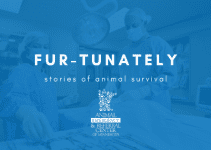
October is Breast Cancer Awareness Month. Did you know pets can get breast cancer, too? Mammary tumors can occur in both dogs and cats and can range in size. Whether your pet is at higher risk or you have already discovered a mammary lump on your pet, we want to guide pet parents through what comes next. From treatment and management options to prognosis expectations, here’s what pet parents need to know.
Here in Part I, we’re discussing mammary tumors in dogs. For more information on mammary tumors in cats, head over to Part II!

Mammary Tumors in Dogs
Mammary gland tumors (MGTs) are the most common tumor in female dogs who have not been spayed.
Quick Facts about MGTs:
- They appear as soft to firm masses under the skin associated with mammary glands
- They range in size, typically from 1-2mm to 10cm
- Your family veterinarian will diagnose the MGT via fine needle aspiration (needle sampling), but sometimes surgical removal is required to obtain a diagnosis.
- Many dogs will have more than one MGT.
- Approximately half of MGTs are benign (non-cancerous), which means the other half are, unfortunately, malignant (cancerous).
- Of the malignant tumors, about 50% of them will spread to nearby lymph nodes and lungs, and less commonly to the bones, brain, liver, and other organs.
- Chest x-rays and an abdominal ultrasound are used to detect the spread of the cancer

Pets at Higher Risk
Various risk factors including age, breed, and hormonal exposure, all play a role in the development of MGTs. Dogs more commonly affected or at higher risk of developing MGTs include:
- Unspayed females (They are at greatest risk – the risk increases with each estrous cycle)
- Obesity early in life
- Middle-aged and older dogs
- Certain breeds, including:
- Poodles
- Chihuahuas
- Dachshunds
- English springer spaniels
- English setters
- Brittany spaniels
- German shepherds
Note: Dogs that are spayed earlier in life have a significantly decreased risk of developing MGTs.

Next Steps
If the MGT is confirmed to be cancerous, your family veterinarian or board-certified oncologist will guide you through treatment options, including:
- Surgery
- Surgical removal of the mass if the cancer hasn’t spread.
- Chemotherapy
- If there is evidence of metastasis (spread of cancer), or if the tumor is high grade, then chemotherapy is often recommended either after or instead of surgery, in order to reduce the risk of the cancer spreading.
- Note: Tumor grade is determined by a pathologist and indicates the abnormality of tumor cells and tissue architecture under a microscope. A higher grade indicates a higher likelihood of aggressive cell behavior, recurrence, and spread to other parts of the body.
- Some veterinary studies show improvement in survival times with chemotherapy, while others do not. At Animal Emergency & Referral Center of Minnesota, our main goal is always to promote a good quality of life, so your pet will receive lower doses of chemotherapy than those used in human oncology patients to avoid the side effects that humans experience.
- If there is evidence of metastasis (spread of cancer), or if the tumor is high grade, then chemotherapy is often recommended either after or instead of surgery, in order to reduce the risk of the cancer spreading.
- NSAIDs
- Non-Steroidal Anti-Inflammatory drugs (NSAIDs) can reduce discomfort and also have some anti-cancer benefit.
Prognosis
Many factors will affect your dog’s prognosis which makes it difficult to estimate how each individual pet will respond to the chosen treatment option. When providing a prognosis, your family veterinarian or board-certified veterinary oncologist will consider:
- Benign tumors are cured with surgical removal
- Tumors greater than 3-5 cm have a worse prognosis than tumors less than 3 cm
- The spread of cancer to other regions of your pet’s body, increased body weight, and a higher histopathologic grade will all negatively affect prognosis
With that being said, the average survival time for dogs with mammary cancer can be as short as six months (typically for dogs with larger tumors that are 3-5cm or a high–grade tumor) or as long as 2+ years (typically for dogs with smaller, non-metastatic tumors).

Read Part II to learn about mammary tumors in cats here.
Finding a lump anywhere on your pet is an alarming discovery, which is why it’s important to consult with your family veterinarian. If you suspect your dog or cat has a mammary lump, or if you have any other concerns about your pet’s health, consult with your family veterinarian. Once a diagnosis is determined, they may decide to refer your pet to a board-certified veterinary oncologist for guidance on your pet’s specific type of cancer, as well as treatment and management options.
Learn more about Animal Emergency & Referral Center of Minnesota’s Oncology Service here.
More Reading:
- Chemotherapy and Quality of Life in Dogs and Cats
- Debunking Pet Cancer Myths
- Early Detection of Cancer in Dogs and Cats: 5 Things Pet Owners Can Do
- 5 Most Common Pet Surgeries at AERC





